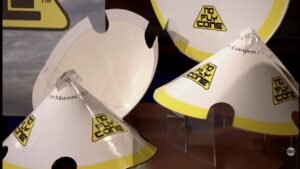Every season, millions watch Shark Tank, rooting for underdogs or counting every dollar flashed on screen. But let’s get real: a handshake with a Shark is only the start. The tough part is what happens once the cameras cut out. Case study for the ages? SlumberPod. Some call it a simple blackout tent for babies. That’s surface-level thinking. Let’s see why SlumberPod broke the mold, scored a deal, and took its hustle nationwide.
Contents
ToggleWhat Is SlumberPod? The Basics, No Fluff
If you’ve ever tried getting a cranky toddler or a peppy puppy to sleep in a strange place, you know it’s chaos. Curtains don’t cut it. Hotel towels over playpens? Forget it. SlumberPod is a pop-up, blackout privacy pod that fits over cribs or travel play yards—now even pet crates. Total darkness, zero distractions. Kids sleep, parents breathe easy, and everyone’s sanity survives vacation.
But here’s the kicker: It’s not just for homes or fancy travel. It’s for any parent or pet owner tired of sleep disasters when routines get rocked. The actual problem SlumberPod solves? Sleep consistency, anywhere. That’s worth big money in the parenting world.

Meet the Founders: Why Lou Childs and Katy Mallory Built SlumberPod
You’ve got Lou Childs and Katy Mallory, a mother-daughter team. Real people, real pain point. This wasn’t a let’s make something cool in a college dorm story. Katy, a new mom herself, hit roadblock after roadblock traveling with her baby. Too much light, no privacy—naps and nights were ruined.
Lou had seen enough—she teamed up with her daughter. Forget waiting on a solution. They built it themselves, tested with friends, launched small, and kept pushing. That’s what it looks like when founders aren’t chasing trends but solving a problem that keeps them up at night—literally.
The Shark Tank Pitch: Season 11, Live Demo Drama
Lou and Katy stepped onto Shark Tank in Season 11, Episode 10—could have been any side hustler’s moment. Their ask? $400,000 for 20% equity. That’s an implied $2 million valuation—not cheap, not desperate.
Now, here’s where it gets raw: Their live demo involved a real toddler… who promptly started wailing, amping up the pressure. Some founders would freeze. Not these two. They leaned in—Yeah, it’s not always pretty, but this is parenthood. And honestly? It played well. Authenticity sells. You can’t fake that in the Tank.
What wasn’t fake? Their sales. $556,000 in revenue before airing, profitable, and no debt. They needed cash to scale up, not to bail themselves out. That’s a power move.

Shark Responses: Who Took the Bait, Who Swam Away?
Now for the Shark Tank chess match. Mark Cuban, Lori Greiner, and Robert Herjavec all opted out. Their logic? The business was cruising already, or it wasn’t their lane. It’s the classic I like you, but I don’t love you moment. And they’re not wrong—solid founders sometimes scare off Sharks looking for early-stage flips.
Kevin O’Leary—Mr. Wonderful—tried the old I’ll give you a loan trick: $400,000 at 9% interest, plus 7% equity. It’s classic O’Leary. He leans into low risk, high control deals.
Barbara Corcoran stepped up where it mattered. First, she wanted a bigger piece—$400,000 for 25% plus a royalty until she got her original money back. The founders stood their ground. In the end? Barbara agreed to the original ask: $400,000 for 20% equity. That’s rare. Most founders flinch or get greedy. Lou and Katy knew their value—and it paid off.
You win in the Tank by holding your ground, not panicking when a Shark pushes. That’s experience money can’t buy.
SlumberPod Valuation and Net Worth: On-Air vs Now
Let’s break down the numbers. On Shark Tank, Valuation = $2 million ($400k for 20%). Those were solid pre-pandemic numbers. Post-appearance? Sales exploded. Revenue’s reportedly jumped past $10 million a year.
Let’s be real—valuations in consumer products can hit anywhere from 2x-5x revenue, depending on margins. SlumberPod’s a DTC company with a killer Amazon presence and now retail deals (Walmart, Target). If you use just 2x annual revenue, you’re talking possibly upwards of $20M in enterprise value now—not bad for an idea born from travel frustration.
Why did they grow so fast? They kept it simple: mobile parents, anxious pet owners, blackout equals better sleep, everywhere. That’s a pitch with serious legs in the parenting and pet market.
What Happened After Shark Tank? Here’s the Real Growth Story
So many Shark Tank businesses fizzle once the airing bump fades. SlumberPod went the other direction.
First, they moved fast—more SKUs, same simple concept. They launched SlumberPod Pets. Same blackout tech, but sized for dogs’ crates. If you’ve seen DTC brands like Bombas or Scrub Daddy, you know this playbook. One hit wonder? No. This is product line expansion done right.
Second, they grew their distribution. DTC-first is old news. True growth means hitting shelves at Walmart and Target, alongside Amazon and their own site (SharkWorth has tracked this jump closely). More eyeballs, easier buying decisions, less friction.
Third, they partnered with eCommerce experts (like Artica)—the result? Instant sales bump, smarter fulfillment, and a stronger operational spine. Scaling is tough—ask any founder. They did it by bringing in grown-up help early.
Where’s SlumberPod Now? Real Numbers, No Hype
Get past the Shark Tank reruns—here’s what’s going on now. They rake in about $10 million annually, maybe more, and the reviews still keep rolling in. They’re profitable, have zero debt, and their expansion into pet sleep has opened up a whole new customer set.
Parents snap up SlumberPods every day. Pet owners jumped onboard. Retailers keep stocking it because it sells. That’s not a one-hit wonder—that’s what hustlers call building a moat. You can’t fake this stage. If SlumberPod was just a viral TV fling, the numbers would have crashed ages ago.
What’s Next for SlumberPod? Smart Bets or Risky Plays?
Every hit product needs its what now? moment. SlumberPod’s doubling down on fresh audiences—think road trippers, cross-country movers, even hotels stacking them for families. They’re expanding geographic reach and considering global logistics. Smart moves.
Are there risks? Always. Margins get squeezed in traditional retail. Supply chain scares can wreck inventory. Copycat products (cheap Amazon knockoffs) will always be a threat in this space. But Lou and Katy seem to know the game—protect the brand, innovate, and keep the customer happy.
My take: this isn’t a get acquired quick play. SlumberPod is built for real longevity if execution stays sharp.
Streetwise Lessons from SlumberPod: What Entrepreneurs Should Steal
Let’s wrap with the playbook. What can you snatch from SlumberPod’s run, whether you’re daydreaming about your own Tank pitch or grinding out on Shopify?
1. Know Your Problem—And Live It
These founders didn’t just identify a pain point. They felt it, night after sleepless night. That’s where the best products come from—and customers feel it.
2. Don’t Flinch on Valuation
Too many founders crumble or get greedy. Lou and Katy played their hand with backbone and got their original terms. Textbook negotiation.
3. Go Wider, Then Deeper
One SKU won’t last forever. SlumberPod added ‘Pets’ without losing focus. It was a natural step, not a forced move.
4. Operational Muscle Beats Flashy Branding
They brought in experts to scale. DTC excitement fades without logistics. That’s what keeps growth real, not just viral.
5. Use TV As a Launchpad, Not a Lifeline
Shark Tank gave them megapixels of attention. But what matters? Strong partnerships, new customers, and keeping the hype alive long after the credits roll.
Want to know if the deal mattered? For SlumberPod, it did. They picked the right Shark, the right moment, and used the spotlight to go national. But it was the hustle after Tank that made them seven-figure survivors, not just another TV footnote.
FAQs SlumberPod Fans Actually Ask
1. Is SlumberPod Shark Tank still in business?
Yes, SlumberPod is not just alive—it’s expanding and thriving worldwide. Visit their official channels or check SharkWorth for the latest.
2. Where can I buy SlumberPod today?
You’ve got options: Walmart, Target, Amazon, and their own website. No hassle, just pick your retailer and go.
3. How much did SlumberPod get valued at on Shark Tank?
On air: $2 million ($400,000 for 20% equity). Today? With $10M+ revenue, it’s easily worth far more.
4. Did Barbara Corcoran really help SlumberPod grow?
Absolutely. Barbara brought in strategy and connections—especially for retail rollout. You see it in their shelf space.
5. Has SlumberPod expanded its products since Shark Tank?
Yes, including SlumberPod Pets for crate-trained animals, with more sleep solutions in development.
6. What are SlumberPod’s annual sales now?
Latest estimates: around $10 million and climbing, thanks to more products and expanded retail.
7. Were there any setbacks after appearing on Shark Tank?
Supply chain hiccups, some copycats, and the usual growing pains. But the team hustled through without major stumbles.
8. Is SlumberPod worth buying for parents or pet owners?
If you travel, share hotel rooms, or have a light-sensitive sleeper, it’s a lifesaver. Downside? Not cheap, but most users say it’s worth every penny
Don’t be fooled by the overnight success story. SlumberPod made Shark Tank work for them, not the other way around. And if you’re building a business, that’s the real trick—use every platform, every deal, every setback, to stack the odds in your favor. That’s how you turn a pitch into a machine.










